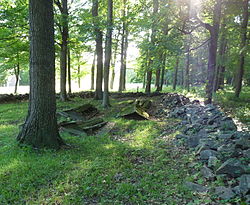Powers Bluff
|
Powers Bluff
|
|
 |
|
| Location | Arpin, Wisconsin |
|---|---|
| NRHP Reference # | 02000732 |
| Added to NRHP | July 5, 2002 |
Powers Bluff is a wooded hill in central Wisconsin near Arpin. American Indians lived there until the 1930s, calling it Tah-qua-kik, or Skunk Hill. Because of their religious and ceremonial activities, Tah-qua-kik is listed on the National Register of Historic Places.
Today part of the hill is occupied by Powers Bluff County Park, locally known for its inner-tube hill on winter weekends. At 1472 feet above sea level, it is the highest point in Wood County.
The most striking geological feature at Powers Bluff is the stone outcrops poking out the top of the hill. In some places they rise 25 feet above the forest floor. The bluff is quartzite with a peak of chert. Geologists believe the quartzite to be from the Proterozoic era, 1.6 billion years old, similar in age and composition to Rib Mountain to the northeast and the Baraboo Hills to the south, and much older than the Himalayas. The quartzite is pretty pink, a semi-precious stone, and very hard. The softer materials which once surrounded it have been gradually stripped away by erosion, leaving the bluff.
Boulders and pebbles of the unusual chert from Powers Bluff are concentrated in a fan shape with its point at Powers Bluff and spreading to the southeast for 20 km, almost to the west side of Rapids. This indicates that a glacier once moved over the bluff heading southeast, breaking off stones and carrying them for miles.
Today most of the bluff is covered by mesic forest dominated by sugar maples - some very old and large. Beneath the trees, spring wildflowers begin to bloom around the second week of April, with mayflowers and Dutchman's breeches plentiful, and some spring beauties, trout lilies, and wild oats eventually giving way to trilliums. During summer, ferns and blue cohosh grow in the shade. Among them, goblin moonwort is a tiny fern that is endangered in Wisconsin. The maples turn red and yellow around the start of October, and soon the forest floor is blanketed in leaves.
...
Wikipedia
